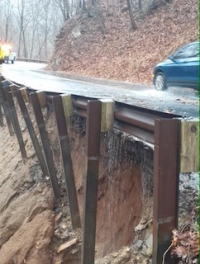Davis was a poetic nature writer
The professional career of biologist Millard C. (“Bill”) Davis — who was born in 1930 in Utica, N.Y., and now resides in Dunnellon, Fla. – included stints as a teacher and editor in various capacities. He has been president of the American Nature Study Society and president of the Audubon New Jersey Wildlife Society. His articles and poems have appeared in The Living Wilderness, New Jersey Outdoors, The Christian Science Monitor, Nature Magazine, Writers’ Journal and Mid-Western Review.
Some of Davis’ finest writing has been about the life and literary career of Edwin Way Teale, in my opinion the greatest American nature writer after Henry David Thoreau. He estimates that he “is now probably 80 percent done” with a biography titled Edwin Way Teale, A Musical Call to Nature.
Davis has published two books: The Near Woods (1974) and Natural Pathways of New Jersey (1997). Both are descriptions of distinctive natural areas. The latter is a county-by-county guide with capsule summaries of 100 of “the finest natural places” in that state. The former is a collection of essays that survey the vast woodlands and associated habitats and micro-habitats of eastern North America. In recent correspondence, Davis recalled some of the events behind the chapter titled “Forests of the Smokies: Northern Summits in the Deep South”:
“In 1965 I was with a group of botanists on a visit to the Smokies to view plant communities. We stayed overnight at the home of Dr. Hal DeSelm (a botanist at the University of Tennessee), who led us up even into (dense tangles of shrubs called) balds ... Eventually I wrote up the trip as “Forests of the Smokies” and sent it to Dr. DeSelm. He liked it (and the article) came out in The Living Wilderness. I placed it in The Near Woods. From this trip, I began a lifelong series of visits into the Smokies — staying overnight, sitting by campfires.”
Most describers of American landscapes plod along. Davis’ descriptions are voiced with poetic crispness and vitality: “A dark horizon seems penciled in by the deep greens of spruce and fir trees.” Words spring to life: “the ultraglassiness of rhododendron blossoms,” or that “genetic oddity, the octoploid ‘skunk’ goldenrod.”
I was so struck by this aspect of his writing that I asked Bill, who visited me briefly in Bryson City last fall, if I could include excerpts in volume two (1900-2009) of an anthology of nature writing from Western North Carolina titled High Vistas, which will be published this spring by The History Press. He agreed. Here are some samples:
Related Items
“The forests of the far north begin where the first scattered trees break the low flat wilderness of tundra. From there a thin lichen-woodland of small trees and lichen-covered ground spreads southward and gradually rises into a towering escarpment, sweeping toward the sky on dark green boughs. Trees of the few species of this boreal forest, this American taiga, may become so densely interwoven to the east that forest animals are born and buried in a perpetually gloomy winter.
“If the aspect of the coniferous forest is peculiar to itself, however, some of the species are not. And a number of them survive as remnants of the ice age in forests that extend far south to the Great Smoky Mountains of Tennessee and North Carolina ....
“Mountain terrain affects the flow of the seasons as though they were strung on strings. Autumn and winter come earlier, spring and summer later, to the higher altitudes. Yet when the hour has arrived in the Smokies, spring rushes through the highest forests and grassy balds like a crackling fire ....
“On the waistline of ridge after ridge, a pink blur appears and gradually spreads across the mountain range in spring. Late one May I stood with a half-dozen friends enshrouded in a few hundred of the millions of soft blossoms that compose this hazy sash. The knees of my pants were slimy with mud, and my cheeks felt inflamed from tiny cuts. Then I bulldozed my way upward once more, emerging finally fifty yards higher up the mountain. Standing to my full height for the first time in perhaps twenty minutes, I looked down over the tangle I had escaped. For nearly 150 yards down the mountain ridge pink rhododendron flowers slid gently among each other ... To me no flower matches the ultraglassiness of the rhododendron blossoms. The pink cups allow a softer light to pass into the shadowed tangle beneath the canopy ....
“As we scrambled down the ridge flank, aiming free-hand style toward the road along the next ridge, a friend and I followed a corner of the slick. The ground fell away before us until suddenly the bushes ended at a ten-foot overhang. We dangled like parachutists over the bounding waters of a twisting mountain stream. Wading across it a few minutes later, we could see up and down stream only a few hundred feet. But we knew that upstream, several miles beyond the first crisp turn, lay the beech-filled cover of a vastly different environment. We were following one of the routes of the southern junco, which trace their migration routes up and down the mountainsides. For every four hundred feet of altitude they fly, they accomplish an equivalent of about four days’ travel northward or southward ....
“In one Lilliputian clearing the yellow bloom of boreal clintonia bobbed in the May breezes. With the sun’s rays falling directly below it, the plant might have been a lantern illuminating a leafy park. Among the plumes of shield fern we found a genetic oddity, the octoploid “skunk” goldenrod (Solidago glomerata)....
“It is the coves that give these ancient mountains their graceful slanting contours. To the observer five or more miles away, their flanks seem to flow across each other.”
George Ellison wrote the biographical introductions for the reissues of two Appalachian classics: Horace Kephart’s Our Southern Highlanders and James Mooney’s History, Myths, and Sacred Formulas of the Cherokees. In June 2005, a selection of his Back Then columns was published by The History Press in Charleston as Mountain Passages: Natural and Cultural History of Western North Carolina and the Great Smoky Mountains. Readers can contact him at P.O. Box 1262, Bryson City, N.C., 28713, or at This email address is being protected from spambots. You need JavaScript enabled to view it..









